Figures & data
Figure 1. Geological setting: (a) Tectonic sketch map of Italy and neighboring regions. Black lines are thrust fronts of Alpine belts; (b) simplified geological map of the Northern Apennines and Corsica (modified after CitationPapeschi et al., 2017). AA: Alpi Apuane; MP: Monti Pisani; MR: Monticiano-Roccastrada; MTR: Mid-Tuscan Ridge; (c) Tectonic sketch map of the La Spezia area highlighting the location of the study area (modified after CitationClemenzi et al., 2015). PBU: Punta Bianca Unit; TD: Tellaro Detachment.
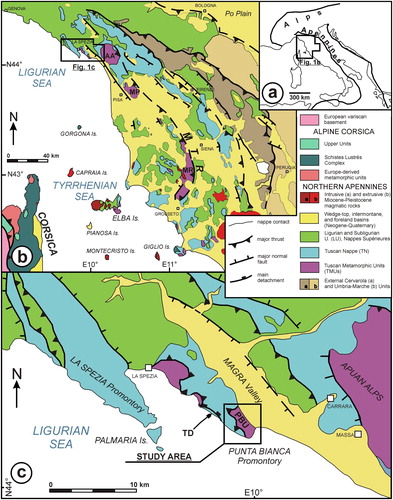
Figure 2. Schematic stratigraphic column of the PBU and the overlying TN in the study area. Letters from A to R mark the lithofacies by CitationRau et al. (1985). Corresponding formations after CitationAbbate et al. (2005) are shown on the right.
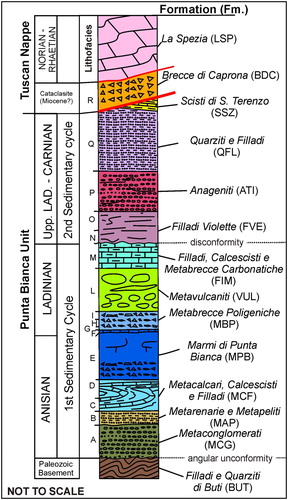
Figure 3. Structures exposed along the D–D’ cross section (see Main Map). From West to East: (a) the TN overlies the W-dipping formations of the PBU. (b) W-dipping attitude of the formations of the PBU. (c) Overview of the contact between the PBU and the TN close to the main W-verging F2 fold (hinge zone in the Verrucano group), crosscut by a D4 shear zone (SZD4). (d) Contact between the Paleozoic basement and the Anisian–Ladinian formations. (e) D5 normal faults affecting the contact between BUT and MCG on the eastern side of the D3 antiform.
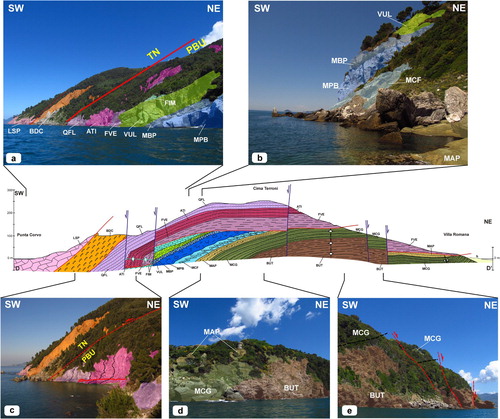
Figure 4. Mesoscale features of the PBU: (a) Quartz-rich metasandstone in the Filladi e Quarziti di Buti Fm. showing a continuous S1 foliation preserved between S2 cleavage domains. (b) SW-verging tight F2 folds developed in the Metacalcari, Calcescisti e Filladi Fm. (c) Relationships between bedding (S0) and the main foliation (S2), defined by flattened marble and phyllite clasts in the Metabrecce Poligeniche Fm. (d) Chocolate tablet boudinage of a grey dolomite vein in the Metacalcari, Calcescisti e Filladi Fm. Gaps are filled by calcite.
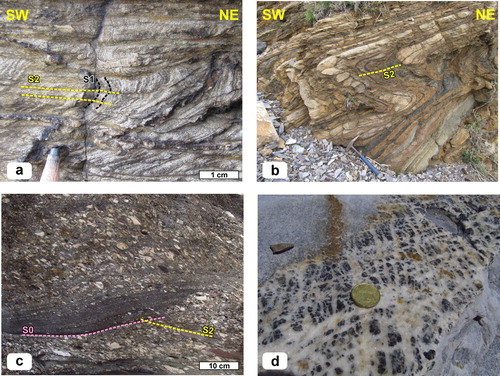
Figure 5. Mesoscale features of the PBU: (a) Symmetric boudinage in the Anageniti Fm. Quartz veins separate boudins of a metaconglomerate layer, whereas the S2 foliation is necked in the surrounding phyllite. (b) Detail of the S2 foliation, crenulated by steep W-dipping S3 foliation planes in a metapelitic interlayer of the Metarenarie e Metapeliti Fm. (c) Small scale D3 thrusts with centimetric westward displacements affecting pre-existing boudins of metasandstone layers at the base of the Metabrecce Poligeniche Fm. (d) D4 shear zones developed in phyllite and quartzite (Quarziti e Filladi Fm.). Top-to-NE sigmoidal structures, containing deformed S3 and S2 foliations, are dragged along top-to-NE low-angle Riedel shears.
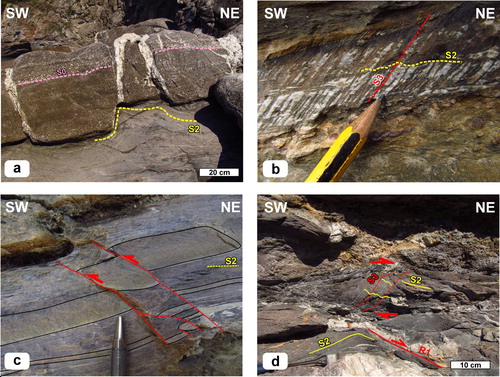
Figure 6. Micrographs collected at (a–b–c–d–g–h) crossed and (e–f) plane polarized light. Mineral abbreviations after CitationSiivola and Schmid (2007). (a) Relationships between the S1 slaty cleavage and the S2–S3 crenulation cleavages in a metasandstone (Metarenarie e Metapeliti Fm.). (b) Intertectonic epidote grain that overgrows the S1 foliation, crenulated by the S2 in the surrounding matrix, observed in a calcschist (Metacalcari, Calcescisti e Filladi Fm.). (c) Deformed quartz and calcite grains in a calcschist (Marmi di Punta Bianca Fm.) showing a shape preferred orientation parallel to the S2 foliation. (d) Face-controlled quartz strain fringes developed around euhedral pyrite grains, parallel to the S2 foliation (Metabrecce Poligeniche Fm.). (e) Flattened calcite-quartz vesicles surrounded by a greenish opaque-Ca-amphibole-chlorite matrix in a metabasalt (Metavulcaniti Fm.). (f) Relic euhedral magmatic plagioclase grain pseudomorphosed to a mix of sericite and chlorite, surrounded by a chlorite + opaque + Ca-amphibole matrix (Metavulcaniti Fm.). (g) Bulging (red arrow) of quartz in a vesicle within metabasalts (Metavulcaniti Fm.). (h) Example of the heterogeneous microstructures shown by quartzite clasts in the Anageniti Fm. Polygonal grain boundaries coexist with cracks, subgrains, trails of recrystallized quartz grains, and deformation bands.

